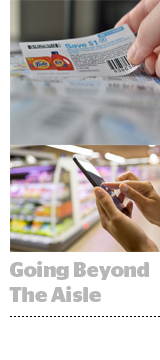 Consumer packaged goods companies are going direct-to-consumer, spurred by a desire for greater data governance and less reliance on third-party retailers.
Consumer packaged goods companies are going direct-to-consumer, spurred by a desire for greater data governance and less reliance on third-party retailers.
As a result, the principles behind shopper marketing, which traditionally centers on in-store promotions, are blurring with brand marketing, which focuses on building brand affinity.
“We’ve seen shopper marketing move from this singular approach to a multidisciplinary model,” said Chris Gray, who leads shopper strategy at Omnicom’s consumer engagement agency, The Marketing Arm.
Because shopper marketing is moving beyond the brick-and-mortar aisle and into mobile and digital, the Association of National Advertisers estimates investment in shopper marketing will increase 5.8% to $18.6 billion by 2020 as more marketers seek to extend their connection to the consumer post-visit.
“Shopper marketing is ultimately about influencing behavior,” Gray added. “It’s becoming more strategic, where we’re bringing [in-store tactics] more upstream in the planning process.”
Making Measurement Strides
As shopper marketing and brand marketing converge, CPG advertisers need more accurate attribution.
A brand like Frito-Lay, for instance, sells most of its products through retail partners, but because the company is a degree removed from the customer, it makes measurement difficult.
Although consumer marketing teams can monitor store-level performance for results like sales lift, it can be tough to connect those insights back to brand impact or reach, particularly if a store has a regional footprint, according to Dana Lawrence, Frito-Lay’s senior director of digital marketing.
Thus, some CPG brands are putting themselves back in the driver’s seat by combining the in-store data they do have with digital insights from partners like MyWebGrocer or Nielsen Catalina.
CPGs used to think in terms of tonnage, said Pat Dermody, the president of mobile commerce platform Retale and former VP of marketing services for Sears, but now they’re more precise.
AdExchanger Daily
Get our editors’ roundup delivered to your inbox every weekday.
Daily Roundup
“You used to buy based on how many squares you got in a circular,” she said. “Now you have the ability to see who actually engages with your content. You’re not paying for a chance to reach people anymore. You pay to actually reach them.”
But sometimes being precise isn’t as effective as reaching a wide swath of consumers the way traditional media might – which is why P&G recently pulled back on super segmented Facebook targeting.
“The core problem for P&G is measuring sales,” explained Michael Provenzano, CEO of Vistar Media. “Most of P&G’s products are not bought online. They’re bought in the physical world. Measurement back to ROI continues to be the [key KPI] for CPGs, auto and retail.”
CPG Prompts New Vendor Demands
Because CPG products have tight margins, advertisers really need provable ROI. This is why vendors are merging their capabilities around multitouch attribution, analytics and data management.
Nielsen’s recent launch of a marketing cloud spurred demand from large global CPGs, which it claims accounts for about 70-75% of new client inquiries.
“Everyone has come to realize that customer data is like gold and [retailers] have been really reluctant to share that with CPGs because it gives them leverage,” said Mark Zagorski, CEO of Nielsen’s eXelate. “That left [CPGs] with a huge blind spot and their only option was to take the direct connections they did have with consumers and map that against third-party data.”
But CPGs are making headway. P&G just launched an online subscription service for popular brand detergent product Tide Pods while Unilever bought startup razor competitor Dollar Shave Club for $1 billion.
The companies hope to reduce dependency on third-party distributors and improve targeting across their own brand portfolio.
“If your brand markets to mothers and she has a baby, you might want to [cross-market her in the next stage of the baby’s life] from another brand in the portfolio,” said Patrick Salyer, CEO of Gigya, which tackles the identity component for CPGs. He noted increased traction with the vertical. “Right now those identities are kind of all over the place, so they’re realizing there’s more value if they unify that data.”













